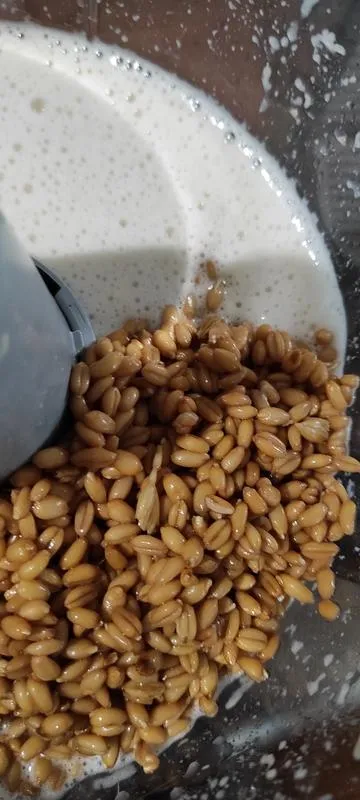

This has to be one of the most interesting (to me) breads I've made in the last couple of months. As I was making it I kept on thinking that this was quite mad scientist and couldn't possibly work.
It all started when I read a stray comment from David (headupinclouds) about the "wet sprouted grain path"....which led me to find Wendy's interesting post here from 2018 about Reinhart's Sprouted Pulp Bread.
And from there it was a short hop skip and jump to take those first tentative steps onto the "wet sprouted grain path". At least some of these tenative steps have been self inflicted, it would have certainly been easier to read Peter Reinhart.
At the time I didn't have Reinhart's "Bread Revolution" book, so the formula that I came up with to make my own was based off some assumptions. The first thought was that maybe 150g of wheat berries to 300g of flour would be a good starting point. It was harder to guess how much water to add, so I assumed that roughly 10% of the mass of the wheat berries was water and germinated the wheat in a closed glass jar so that I could have a rough idea of the added hydration. Also, I made the assumptions that 3 days would be about right for germination of the sprouts, although my kitchen is a cold 17 deg C at this time of the year.
And, based on these assumptions, and treating the sprouted wheat as another flour I initially aimed for '70% hydration' overall, figuring that it is better to be underhydrated and have control over the dough and add in water later by bassinage if needed. It turned out to be needed too - 50g of the water listed above in the formula needed to be added in via bassinage. The wheat husk and endosperm are certainly good at doing what they do when it comes to locking in (or out) the moisture.
The food processor with the sharp metal blade was used for pulping the sprouted wheat berries, and since I didn't really want to wash multiple containers I also used it for mixing the dough. I started out with a slurry of levain and the initial amount of water (178g) and into this the sprouted wheat was added for pulping. It was necessary to run the machine for around 3 minutes until the mixture no longer showed large wheat pieces. On top of this the high protein sifted bread flour was poured, with a total mix time thereafter of around 35 (20+15) seconds to make the final dough. There was a rest between the two mixes so that the dough could fermentolyse. When it came out of the food processor the dough had strong gluten and was taut and rubbery, and it was then left in a bowl in the proofing box for about an hour before the salt and additional bassinage water was added by hand. The bassinage the excessive rubbery gluten texture.
If I was to repeat, I think it might be interesting to pulp the wheat berries first to see what the pulp looks like (and to smell it) on its own without the levain slurry, although the method of mixing used clearly turned out to be effective and there was nothing wrong with it.
From Wendy's post the raisins and nuts looked like interesting inclusions, but I didn't want to overdo the inclusions on the first attempt, so there were inclusions, but only a small amount of dry cranberries and walnuts from leftovers in the cupboard. Inclusions were laminated in, thereafter followed by a couple of coil folds about hourly, with shaping at a low volume increase of 20% and the banneton went into the fridge for a retard at a volume increase of approximately 45%. Normally I like to go a little bit bigger than that, but the levain wasn't as active as I'd have liked.
The levain is my new desem culture which I've been playing with storing semi dehydrated in the fridge, and probably it should have had an additional day growing in the warm proofer with one extra levain build step before use. It is weird to think that the desem levain was started from the same bag of wheat kernels that I used for this bread, at least there is some consistency with the yeast and bacteria species found on the seeds and what is being used in the levain culture, although the whole thing felt kind of cannibalistic!
This bread was lovely to eat. I can see why all the bakers who make pulp breads say they will do it again. The taste was more neutral than sweet, but it certainly did not have the sour taste notes that I associate with sourdough and wholewheat. It was a little denser than I like, and I suspect using emmer or kamut are worth exploring as Reinhart suggests, although even using regular wheat result in a "power" bread that is digestible and nutritious.
Today I bought an ebook version of Reinhart's book to finally see the recipe for his "sprouted emmer pulp power bread". Definitely on the path now. And, can see why his bread is less dense - the ratio of kernels to flour in his recipe has more flour, and he even added some VWG which I see could be beneficial. Plus, he also used a lot more of the good stuff, the raisins and nuts! Definitely will try his recipe too, there will certainly be a next time.
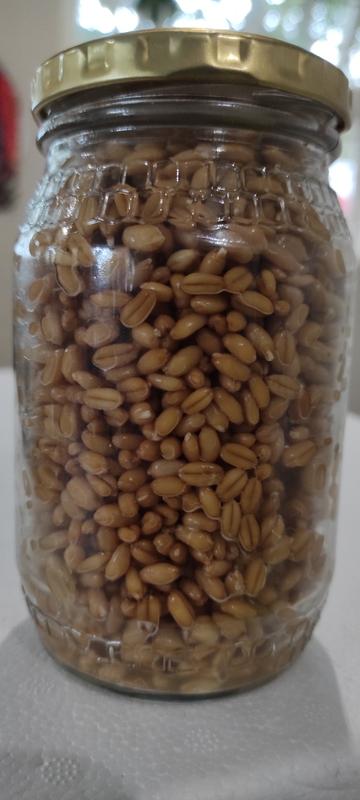
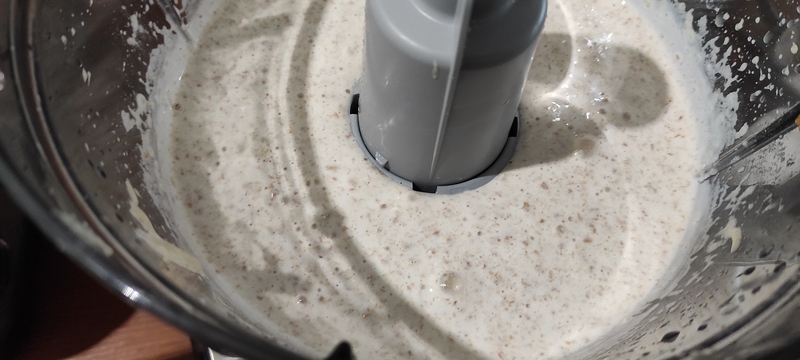
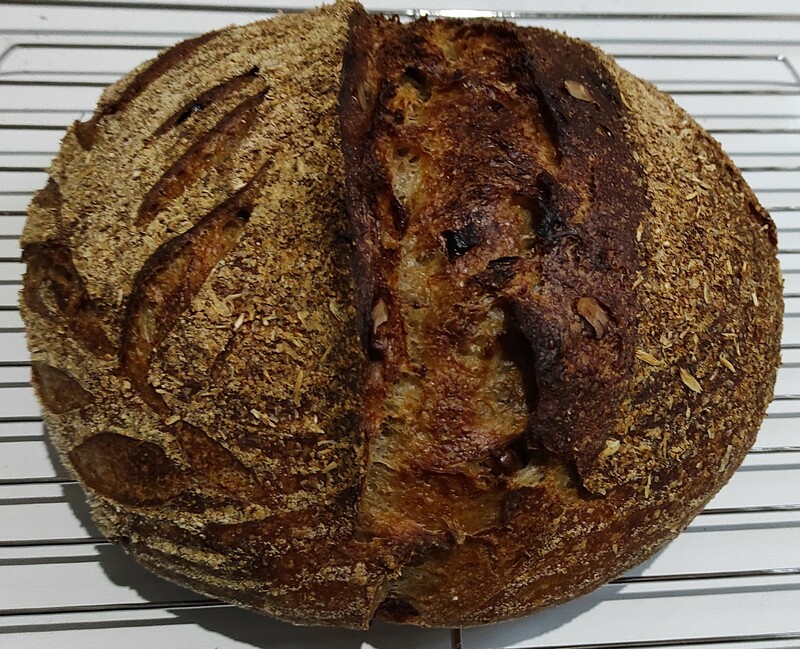
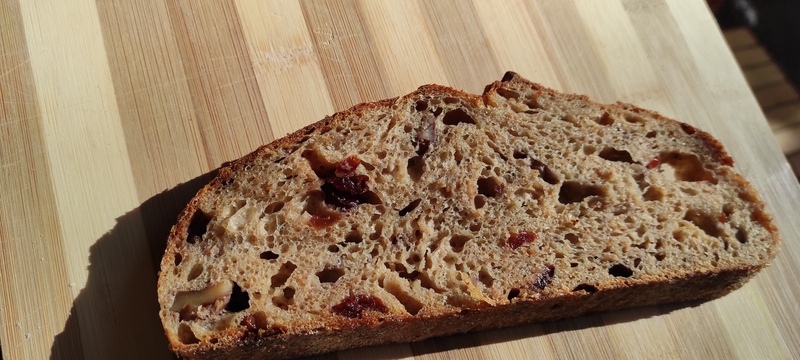
- JonJ's Blog
- Log in or register to post comments
Thanks for sharing your process and your bake.
"The wheat husk and endosperm are certainly good at doing what they do when it comes to locking in (or out) the moisture."
I assume you meant "bran." On modern farms, wheat husks are removed by the harvesting machine (a.k.a. "combine") before they even leave the field.
In lesser-developed countries, removal of the husk may still be a separate process after harvesting.
Here's a detailed explanation between husk and bran: https://pediaa.com/what-is-the-difference-between-husk-and-bran/ (He gets a couple details wrong, but overall it's okay.)
That link didn't have good photos, so...
Here's some wheat husk: https://www.indiamart.com/proddetail/wheat-husk-13467098030.html
And here is some wheat bran: https://centralmilling.com/product/organic-flaky-wheat-bran/
A lot of folks on TFL take things literally so it's good to use standard terminology whenever possible.
I -think- I see one berry that still has its husk, in your first photo, near the center of the photo. I don't have the tools on my ipod to edit in a circle and repost.
I don't see enough detail on my small ipod, but I think it's possible that your loaf is covered in ground husks. Is that possible? Did you buy "berries still in the husk" or perhaps bulk "wheat husk" ? I'm confused.
If you catch those berries-with-their-husk-still-on before milling or sprouting, you should either roll the berry between your fingers to remove the husk (and throw away the husk) or ... throw out the berry if the husk won't come off.
I have purchased wheat berries in 25, 45, and 50 pound bags/pails. I never really counted, just going by my memory impressions, I'd say a wheat berry still covered by its husk occurs about 3 times (that is... just 3 berries) for every 5 pound batch of wheat that I mill at home. Some bags, years, brands, and varieties of wheat are better than others.
Yes, I manually inspect all my wheat before milling, 1/8 cup at a time, spread over parchment paper. That way I can remove malformed, broken, green, spoiled, or excessively black-pointed berries, and any non-wheat material.
If you mill an occasional berry-with-its-husk into flour, it's no big deal. But... using them whole or "pulped" ... it's a not-entirely-pleasant eating experience.
Please don't intentionally eat "wheat husks" (though the occasional one ground into flour likely won't harm you). Husks (true husk, not bran) are for animal feed, or sometimes farmers plow the husks back into the ground.
Hi Dave, thanks for the clarification. Thanks for the correction, yes you're quite right and have got sharp eyes. This is where some botanical training gets in the way! I meant to type endosperm and pericarp but after filtering through my brain that became husk! My brain gets even worse when it comes to calling these seeds "berries", but I digress.
That husk in the pic was actually posed there, I fished it out before running the machine! The topping on the bread was some bran sieved from a supermarket bag of wholewheat, but it did look a little coarse.
Tell me, do you think that I sprouted for long enough before using. Even though it was three days those radicals still looked like they could do with a little more time, I'm just not sure what we should look for when it comes to doing this for baking.
"Tell me, do you think that I sprouted for long enough before using. Even though it was three days those radicals still looked like they could do with a little more time, I'm just not sure what we should look for when it comes to doing this for baking."
All I know in regard to that is what is in Reinhart's Bread Revolution.
He has a blog somewhere, where an email address is given, if you want to contact directly.
AFAIK, you do want to cut the sprouting process short, or else too much starch can be converted to sugar. What point that is, in terms of length of radical/sprout/spikelet/watchamacallit, I don't know.
I just checked my hardcopy Bread Revolution. The side bars on print page 48 and print page 141.
Page 48 says the ideal time is when the "nub" splits into 2 thin shoots. I suppose "nub" is the same as "radical."
If the ebook doesn't show print-page numbers, do a search for "nub splits into two thin shoots"
Thanks, I must spend more time with my book. And for the next bread I will sprout it in a jar with a mesh (the same as you do for bean sprouts).
The way I did it, in a sealed jar, isn't the best way to sprout anything as there is no drainage and it probably isn't a good idea to go many days like that which is why I somewhat nervously stopped at 3 days.
"The topping on the bread was some bran sieved from a supermarket bag of wholewheat, but it did look a little coarse."
Do you mean:
1) it was in a bag of wholewheat un-ground berries?
Or do you mean:
2) it was in a bag of wholewheat pre-ground flour?
If #1, then that's not bran, bro. That's husk.
If #2, then that's very low quality flour. And it still might be some husk.
---
Next... what exactly do you mean by "hard white sifted flour" in your spreadsheet?
Did you purchase that as a flour at a store? Or did you start with hard white wheat berries, mill it at home, and sift it yourself? Or did you start with hard red wheat berries, mill it yourself, sift it, and call it "white" because you took some/most of the bran out?
("white" has 2 meanings in the flour realm. It usually means a refined flour that has had virtually all of the bran removed, such as All-purpose flour, or Bread flour. But it is also a type of wheat that has less tanins in the bran than red wheat varieties, so it describes the color of the berry, not the refined-ness of the flour. So it has a different meaning to home-millers.)
--
(Sorry for being a pedantic anal-retentive comminicator, but you've taken on a very technical hobby, where trouble-shooting requires precise terms and specifications. And i'm firmly on the autism spectrum.)
Learning a lot and I for one appreciate the attention to detail.
So, when it comes to the topping, it was from a bag of flour purchased from the supermarket, which I sieved at home to extract what I thought was bran. The flour says on the bag "Stone ground unsifted whole wheat flour". It's cheap and not the best quality, but is it a case then that millers include husk in their flour?! Didn't know that. Here's the flour, if you're curious - http://www.gideonmilling.co.za/gm-home/#pages - "Everything milled is in the bag including the wheat germ."
By the way, this sort of thing, with germ included isn't as rare here as I suspect it to be in the States but it does mean I have to be watchful of the best before date, and if I had the space store it in the freezer. And on the side of the bag it just says: Ingredients: wheat (gluten). So, no ascorbic acid, thiamine, malt, calcium proprionate, datem, etc, etc, just the wheat man.
Then, there are my more special flours, which do not come from the supermarket but rather from a middleman that purchases from farmers and sometimes makes sprouted flours from the wheat he purchases. I'm really lucky to have him, but I guess this is one of those speciality items that caters to food lovers willing to pay a premium, and is a far different and more variable product to supermarket purchased flours.
For the flour included in the bread, the farmer grows a Winter "Hard white wheat (not certified organic) - a white wheat cultivar developed for pasta with a high protein content and sweeter taste profile. Exceptional in sourdough breads and pizza".
This particular flour was milled by the farmer, and sieved as well. Apparently it has 14.6% protein for the current crop, which is quite rare in these parts - our typical flours have 11.5% or so. You can certainly notice the gluten when you bake with it. And it gives a bread with a very soft crust by default (which to me is most indicative of the absence of bran). This is the farmer's website - https://lowerland.co.za/pages/grains-flour
-Jon
Thanks for sharing your process Jon that sounds and looks like a very good loaf. It’s great that you’re exploring new avenues.
Benny